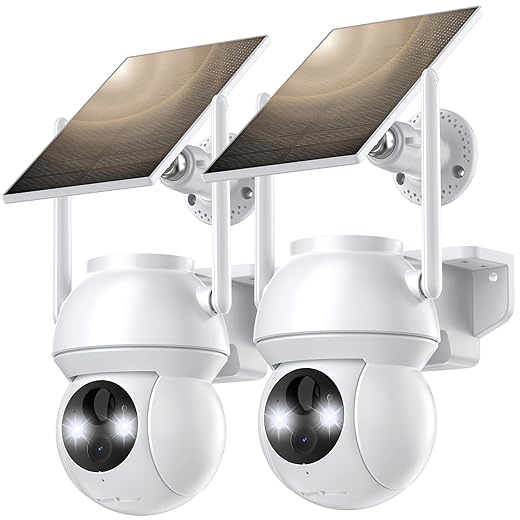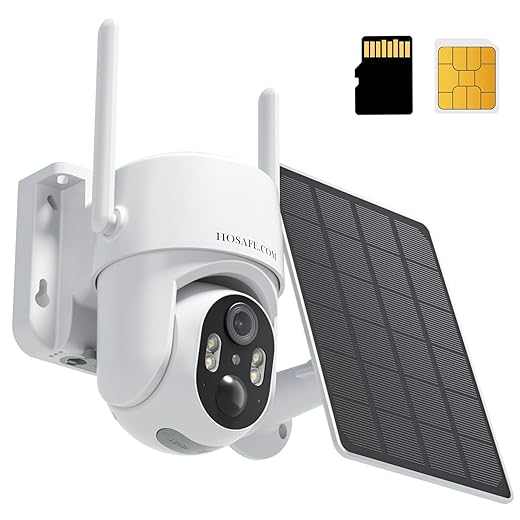Introduction to WiFi-Free Security Solutions
As technology advances, security solutions are evolving to meet the diverse needs of homeowners. In today’s world, the demand for security cameras that operate without WiFi is on the rise. These cordless devices provide reliable protection without the complications of internet connectivity, making them an appealing option for those seeking enhanced privacy and security.
Going WiFi-free means people can enjoy the benefits of surveillance without worrying about network interference or vulnerabilities associated with online connectivity. Whether residents are looking for easy installation or robust performance, security cameras without WiFi offer a practical alternative. This article will explore the advantages of these devices, the different types available, and guide users through selection, installation, and maintenance to ensure maximum effectiveness in protecting their homes.
Amazon.com
Understanding Security Cameras Without WiFi
Security cameras without WiFi are designed to provide surveillance capabilities without relying on internet connectivity. These cameras come in various types, utilizing alternative technologies to ensure reliable monitoring. Unlike traditional WiFi-enabled models which often face connectivity issues, WiFi-free security cameras function effectively even in the absence of a home network.
Types and Technology
There are primarily two types of technology behind WiFi-free security cameras:
- Cellular Connection: These cameras use a cellular network to transmit video and images. By purchasing a data plan, users can receive real-time alerts and view footage from anywhere, similar to how smartphones operate. This option is particularly beneficial for remote properties or locations where internet access is unreliable.
- Local Storage Options: Many non-WiFi cameras come equipped with features allowing them to record footage directly onto local storage devices, such as SD cards or built-in memory. This can be an effective way to ensure that important video data is securely captured without needing an online connection.
Functionality and Differentiation
The functionalities of WiFi-free security cameras may include:
In essence, WiFi-free cameras stand out by prioritizing stability and reliability. Users can avoid the frustrations tied to WiFi connectivity while maintaining control over their home security. Next, let’s dive deeper into the numerous benefits that come with choosing a WiFi-free solution for home surveillance.
Benefits of Going WiFi-Free
Choosing to go WiFi-free with security cameras comes with multiple advantages that enhance both reliability and peace of mind.
Enhanced Reliability
One of the key benefits of WiFi-free security cameras is their increased reliability in monitoring. Traditional WiFi-enabled cameras can suffer from connectivity issues due to various factors such as network interference, router malfunctions, or even outages. In contrast, WiFi-free cameras, whether they operate on a cellular network or local storage, ensure continuous surveillance without the risk of losing connection. This is particularly valuable for homeowners in rural or remote areas where internet access can be sporadic.
Reduced Risk of Hacking
Security is paramount when it comes to home surveillance. WiFi-enabled cameras can be susceptible to hacking, leaving personal data and footage vulnerable to intruders. By utilizing a WiFi-free system, users significantly minimize the risk of unauthorized access to their security feeds, as there’s no internet gateway for potential hackers to exploit. This added layer of security provides not just protection against physical threats, but also peace of mind regarding cybersecurity.
Optimal Performance in Remote Locations
WiFi-free security cameras are particularly beneficial for locations without reliable internet access, such as vacation homes, cabins, or agricultural properties. With the ability to operate either autonomously or via cellular data, these cameras ensure that residents can monitor properties effectively regardless of their geographic challenges.
Cost-Effective and Eco-Friendly
In terms of practicality, users of WiFi-free systems can further capitalize on cost savings. By eliminating the need for data-heavy transmissions associated with online service plans, families may find themselves spending less on data and maintenance. Additionally, many of these cameras use battery power or solar energy, making them energy-efficient options for homeowners looking to decrease their carbon footprint.
In conclusion, the advantages of going WiFi-free are numerous and compelling, making these systems an attractive choice for a diverse range of homeowners. As we move forward in this exploration, the next section will delve into the types of WiFi-free security cameras available on the market today, helping consumers make informed decisions tailored to their specific needs.
Types of WiFi-Free Security Cameras
As homeowners explore WiFi-free security solutions, it’s essential to understand the different types of cameras available. Each offers unique features and functionalities tailored to meet various needs, ensuring effective surveillance without the reliance on internet connectivity.
Battery-Powered Cameras
Battery-powered cameras are a popular choice for homeowners seeking easily deployable options. These cameras operate independently, making them perfect for remote locations or areas where power sources are limited. They feature rechargeable batteries, and users can expect several weeks of operation on a single charge, depending on usage. This kind of flexibility allows for placement in different areas around the home, from driveways to backyards.
Solar-Powered Cameras
For those looking to integrate sustainability into their home security, solar-powered cameras provide an eco-friendly alternative. These cameras utilize solar panels to recharge their batteries, ensuring continuous operation without the need for manual charging. Ideal for outdoor use, they require good sunlight exposure but can work efficiently even on cloudy days. The adaptability of these cameras is particularly advantageous for homes in sunny regions, making them a practical choice for security while promoting energy efficiency.
Cellular Network Cameras
For homeowners wanting real-time monitoring and notifications, cellular network cameras are the way to go. These cameras operate through a mobile data connection rather than relying on WiFi, ensuring users can receive updates and stream footage from anywhere. They are particularly useful for vacation homes, remote sites, or urban areas with weak internet service. A subscription to a cellular data plan allows seamless communication and constant surveillance, offering peace of mind to users.
Local Storage Options
Many WiFi-free cameras utilize local storage options, such as SD cards or internal memory, allowing users to store footage without needing to connect to the internet. This feature ensures that important data is captured securely and can be accessed directly from the camera, making it an appealing choice for those prioritizing data privacy and security.
Understanding these types of WiFi-free security cameras equips homeowners with the knowledge necessary for making informed choices tailored to their specific needs. As technology continues to evolve, the forthcoming section will highlight some of the top picks available in the market, helping to narrow down options for prospective buyers.
Top Picks for Cordless Security Cameras
When it comes to choosing the right cordless security cameras, several models stand out in the market for their features, ease of use, installation process, battery life, and overall value. Here is a curated list of top-rated options that cater to various needs and preferences.
Arlo Go 2
The Arlo Go 2 is a versatile cellular security camera designed for users who require mobility without sacrificing quality. Capable of delivering 1080p HD video, it features night vision, two-way audio, and a robust battery life that can last several months on a single charge.
Priced around $499, it’s perfect for remote properties or travel enthusiasts wanting peace of mind wherever they go.
Ring Stick Up Cam Solar
For eco-conscious homeowners, the Ring Stick Up Cam Solar is a must-consider. This innovative camera uses solar energy to keep its battery charged, minimizing energy consumption while providing effective monitoring.
Retailing for approximately $199, this model strikes a balance between affordability and functionality, making it a popular choice for outdoor security.
Blink Outdoor
The Blink Outdoor camera is known for its impressive battery longevity, lasting up to two years on a pair of AA batteries, making it an extremely low-maintenance option.
With a starting price of $99.99, it’s an excellent entry-level camera for budget-conscious users without compromising quality.
Reolink Go
Another standout is the Reolink Go, which combines flexibility and power with its 4G LTE connectivity. This camera is perfect for those in locations where WiFi is simply not an option.
At about $199, it fits nicely into the budget of homeowners looking for reliable mobile surveillance.
eufy Security eufyCam 2C
Last but not least, the eufy Security eufyCam 2C offers an excellent mix of features and user-friendliness. This model provides local storage without any subscription fees.
With a price tag around $199, it’s an ideal choice for users seeking a complete security solution without ongoing costs.
These top-rated wireless security cameras cater to a variety of preferences and requirements, making them valuable assets for any home. Understanding what options are available will guide users to select the ideal fit for their personal security needs. In the next section, we’ll explore the best practices for installation and maintenance of these WiFi-free cameras to ensure optimal performance and longevity.
Installation and Maintenance of WiFi-Free Cameras
When it comes to securing your home with WiFi-free cameras, proper installation and regular maintenance are crucial for achieving optimal performance. Here are some essential tips that homeowners can follow to effectively set up and manage their security systems.
Optimal Camera Placement
Placement is key to maximizing the effectiveness of any security camera. Here are some guidelines for optimal positioning:
Battery Management
For battery-powered or solar-powered cameras, effective battery management ensures uninterrupted security. Follow these practices:
This camera is designed to thrive in outdoor environments, ensuring reliable coverage with consistent power solutions.
Troubleshooting Common Issues
Though WiFi-free cameras are generally easier to maintain, issues can arise. Here are common problems and solutions:
By staying proactive with installation practices and monitoring battery health, homeowners can ensure their WiFi-free security cameras function effectively. The forthcoming section will delve into a cost comparison between WiFi-free solutions and traditional WiFi security systems, helping consumers further evaluate their options.
Comparing Costs: WiFi-Free vs. WiFi Security Cameras
When considering security camera options, cost is a significant factor that homeowners should weigh carefully. This section analyzes the financial implications of choosing WiFi-free security cameras over their WiFi-enabled counterparts.
Initial Investment
Initially, WiFi-free cameras can appear more expensive than WiFi models. However, the long-term savings often make them a better investment. WiFi-enabled cameras typically require additional expenses for purchasing a WiFi router or upgrading an existing one, which can range from $50 to $300 depending on the quality and features.
On the other hand, many WiFi-free cameras, like the Arlo Go 2 and Blink Outdoor, come with no hidden setup costs. With prices starting around $99.99, these cameras often include features that WiFi cameras may charge extra for, like local storage.
Ongoing Costs
Data plans are a recurring expense when using cellular network cameras. Depending on the provider, users could face monthly charges ranging from $10 to $50, depending on the data usage. This expense is typically absent from WiFi-free models that store footage locally or work with rechargeable batteries.
In contrast, WiFi security cameras might require cloud storage subscriptions for saving footage. These can add up considerably—often costing between $3 to $30 a month. Over time, these fees can lead to substantial yearly expenditures.
Savings from Security Breaches
Another aspect to consider is the potential for loss due to theft or property damage. WiFi-enabled cameras are vulnerable to hacking if not properly secured, leading to compromised footage or stolen data. The loss of valuable items or having to increase security in response to breaches can far outweigh the upfront costs of WiFi-free systems.
Example Comparison
For a clearer picture:
These comparisons clearly reveal a substantial long-term financial advantage for WiFi-free systems.
By examining these cost dynamics, homeowners can better appreciate the value of opting for WiFi-free security solutions. As the discussion moves toward the final section, it’s essential to consider the overall benefits of adopting these systems for both budgetary and security reasons.
Final Thoughts on WiFi-Free Security Solutions
In a world increasingly reliant on wireless connectivity, WiFi-free security cameras offer a refreshing alternative for homeowners seeking reliability and peace of mind. As discussed, these systems eliminate the vulnerabilities associated with WiFi networks while providing robust security features. With various types available, from battery-operated models to those with local storage, there’s a solution to fit every need.
Ultimately, choosing the right security camera hinges on understanding one’s specific requirements and weighing the benefits of a cord-free approach. For those looking to enhance their home security without the complexity of WiFi, exploring WiFi-free options can lead to increased safety and simplicity. It’s time to take control of home security by investing in a WiFi-free solution that aligns with a smart, efficient lifestyle.










I’m intrigued by the Solar Wireless Security Cameras! But… do they really work in bad weather? I live in a pretty rainy area. ☔️
I live in a rainy area too, and I’ve had no issues with mine! Just make sure to install it properly.
Yes, Michael! Most solar cameras are designed to withstand various weather conditions. Just read the reviews for specific models.
Wow, this article is a game changer! I never thought I could have a security system without WiFi. The Blink Outdoor 4 – 2 Camera System looks perfect for what I need. I’m always worried about my package deliveries. 😂 Has anyone tried it?
I have the Blink Outdoor 4 – 5 Camera system! It’s been awesome for monitoring my front porch. Super easy to set up too! 🥳
Glad to hear you’re enjoying the Blink system, Mark! The multiple camera option really helps with coverage.
I’m a bit skeptical about these WiFi-free cameras. Are they worth the investment? How much do the data plans cost? 🤷♂️
Yeah, I guess it’s about what you value. Security is worth it to me!
It really depends on your needs, John. Some users find the subscription fees reasonable for peace of mind.
I’m all about cutting the cord! The benefits of not worrying about WiFi hacks are huge. Just ordered the Tapo TP-Link C120. Fingers crossed it’s as good as they say! 🤞
Keep us posted on how it works out for you! I’m curious about the setup process.
Good luck, Chris! The Tapo TP-Link has great reviews for video quality!
Just read this article while waiting for my Blink Outdoor 4 – 2 Camera System to arrive! I’m excited but also nervous about the installation. Anyone have tips?
Definitely check the installation guide! It makes a big difference.
It’s super easy! Just follow the instructions, and you’ll be up and running in no time.
LOL, I love the idea of going WiFi-free and telling my friends! But really, can I trust these cameras? Are the video quality and alerts reliable?
Most users report good quality! Just make sure to choose a model with solid reviews.
I’ve had great luck with mine! Just don’t forget to check the camera’s specs.
Is it just me, or does going WiFi-free sound like a hassle? I mean, charging cameras and dealing with data plans? 🤔
That’s a valid point, Jessica. It requires some adjustment, but many users find it worth it for the security benefits.
I felt the same way at first! But once I set up the Blink system, it wasn’t so bad. You get used to it!
I read that WiFi cameras can be hacked easily… that’s super scary! I’m convinced I need a 4G LTE camera now. Which one do you recommend?
Yes, that one’s been awesome for me! Perfect for outdoor coverage.
The 4G LTE Solar Security Camera is a great choice! It has good features and positive feedback.
It’s great to see options for those of us who don’t have WiFi. But are these cameras really reliable without it? I worry about missing alerts or footage. 😬
I think they’re pretty reliable! I have the 4G LTE Solar Camera and it works like a charm. No WiFi needed!
Great question, Emily! Many of these cameras have built-in storage and can send alerts via cellular networks.